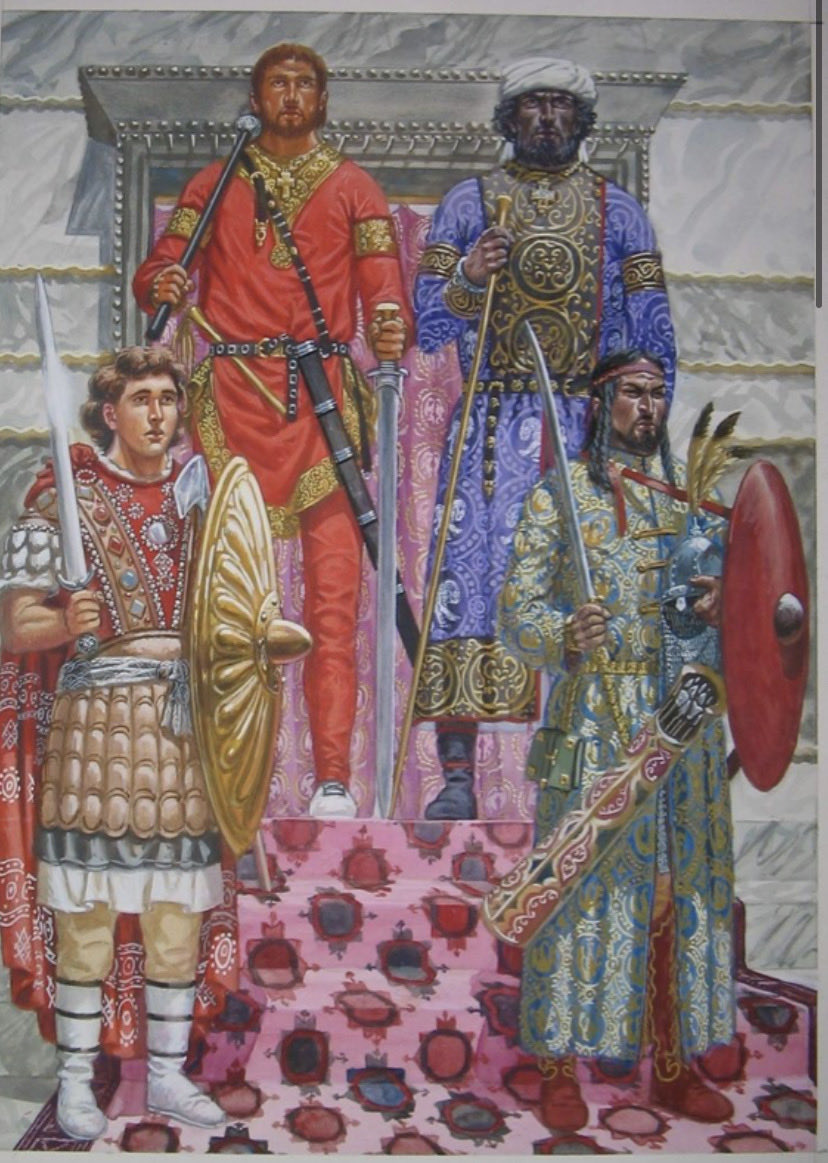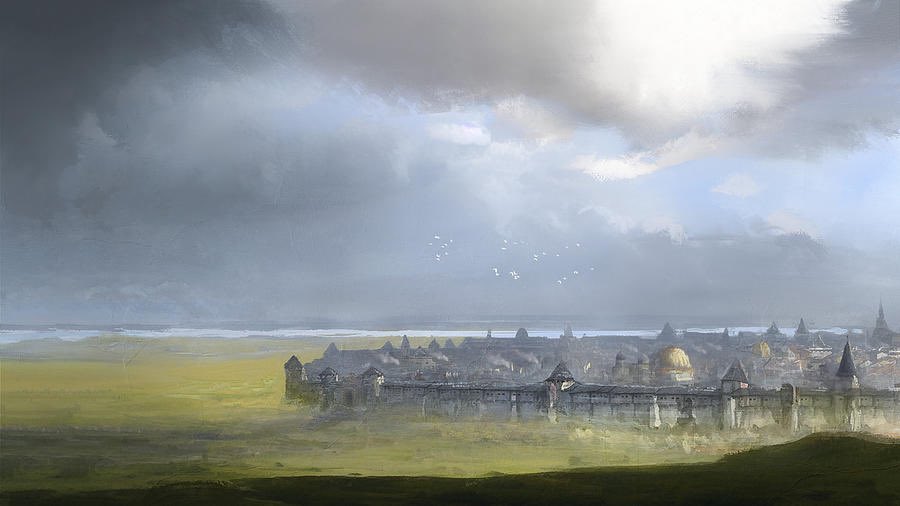
Medieval stories from Europe’s eastern frontier
21 subscribers
How to get URL link on X (Twitter) App


 The medieval steppe of S. Ukraine was controlled by nomads, any settlement was under constant threat by Turkic bands that drove their great herds across the plains.
The medieval steppe of S. Ukraine was controlled by nomads, any settlement was under constant threat by Turkic bands that drove their great herds across the plains.

 “[The treatise might not offer] much application in the eastern regions at the present time. For Christ, our true God, has greatly cut back the power and strength of the offspring of Ishmael and has repelled their onslaughts…
“[The treatise might not offer] much application in the eastern regions at the present time. For Christ, our true God, has greatly cut back the power and strength of the offspring of Ishmael and has repelled their onslaughts… 

 The final siege of Constantinople is the last chapter in the swan song of the Late Byzantine Empire & a dramatic tale of betrayal, duty, determination, honor, and horror.
The final siege of Constantinople is the last chapter in the swan song of the Late Byzantine Empire & a dramatic tale of betrayal, duty, determination, honor, and horror. 

 After the Muslim conquest of Sicily, Sardinia was isolated from the rest of the empire. The Byzantines had more pressing matters & through negligence, Sardinia slowly gained a measure of de facto independence.
After the Muslim conquest of Sicily, Sardinia was isolated from the rest of the empire. The Byzantines had more pressing matters & through negligence, Sardinia slowly gained a measure of de facto independence. 

 As Themel prepared the Holy Mystery a messager burst into the church to announce that Muslim raiders had been spotted marching toward the village.
As Themel prepared the Holy Mystery a messager burst into the church to announce that Muslim raiders had been spotted marching toward the village. 
https://twitter.com/l0m3z/status/1785079985612718412There is no scrutiny of sources or historiography, these are broad strokes to get the scene set for another chapter in a 1,400 year cage match.

 Many came as mercenary warrior bands looking for employment. These were enrolled within the military and given regular pay & orders under the watchful eye of Byzantine officers.
Many came as mercenary warrior bands looking for employment. These were enrolled within the military and given regular pay & orders under the watchful eye of Byzantine officers. 

 The men explained to the Emperor that they were Rhos, and subjects of a Khagan who ruled the river lands north of the Black Sea. Their way home had been blocked by steppe nomads and they asked for his help in traveling back.
The men explained to the Emperor that they were Rhos, and subjects of a Khagan who ruled the river lands north of the Black Sea. Their way home had been blocked by steppe nomads and they asked for his help in traveling back. 

 By the end of the 800s AD Charlemagne’s Empire had collapsed into a mess of squabbling warlords. Vikings overran England, besieged Paris. Magyars trampled over the fertile interior. Muslim raiders reached the walls of Rome itself. These attacks degraded central control further
By the end of the 800s AD Charlemagne’s Empire had collapsed into a mess of squabbling warlords. Vikings overran England, besieged Paris. Magyars trampled over the fertile interior. Muslim raiders reached the walls of Rome itself. These attacks degraded central control further 

 With most of the Caliphate’s fleet now charred flotsam in the Sea of Marmara, Leo III took advantage of his enemy’s weakness. In the same year of his victory at Constantinople a fleet was dispatched to Latakia, the main naval base of the Caliphate.
With most of the Caliphate’s fleet now charred flotsam in the Sea of Marmara, Leo III took advantage of his enemy’s weakness. In the same year of his victory at Constantinople a fleet was dispatched to Latakia, the main naval base of the Caliphate. 

https://twitter.com/peter_nimitz/status/1718153802912784649The continued belief in imperial legitimacy, that only the Emperor in Constantinople can rule, allowed political survival. This was largely thanks to a centralized tax system & Constantinople’s size/impregnability.


 In the decade of chaos following the battle of Manzikert, Byzantine rule in Anatolia was swept aside as the imperial government convulsed in coups & rebellions. The largely demilitarized population of W. Anatolia surrendered as resistance continued in the better-prepared East.
In the decade of chaos following the battle of Manzikert, Byzantine rule in Anatolia was swept aside as the imperial government convulsed in coups & rebellions. The largely demilitarized population of W. Anatolia surrendered as resistance continued in the better-prepared East. 



 “I rained destruction upon them. I scattered their corpses far and wide, filled the face of the desolate plain with their widespreading armies. With weapons I made their blood to flow down the valleys of the land. The plain was too small to let their bodies fall, the wide countryside was used up in burying them. With their bodies I spanned the Arantu as with a bridge. In that battle I took from them their chariots, their cavalry, their horses, broken to the yoke.”
“I rained destruction upon them. I scattered their corpses far and wide, filled the face of the desolate plain with their widespreading armies. With weapons I made their blood to flow down the valleys of the land. The plain was too small to let their bodies fall, the wide countryside was used up in burying them. With their bodies I spanned the Arantu as with a bridge. In that battle I took from them their chariots, their cavalry, their horses, broken to the yoke.”

 Primarily found throughout the Fertile Crescent, tells rise from the flat floodplains like small mesas, distinct for their low sloping sides and flat tops. The first residents of these places lived in agricultural communities & towns at the same level as the surrounding area.
Primarily found throughout the Fertile Crescent, tells rise from the flat floodplains like small mesas, distinct for their low sloping sides and flat tops. The first residents of these places lived in agricultural communities & towns at the same level as the surrounding area. 

 A Norse Khagan ruling on the gateway to the steppes, ranging at the head of an armada across the open seas instead of the grass oceans of Eurasia seems too curious to be true & although still shrouded in mystery, the Rus Khaganate is not without precedence.
A Norse Khagan ruling on the gateway to the steppes, ranging at the head of an armada across the open seas instead of the grass oceans of Eurasia seems too curious to be true & although still shrouded in mystery, the Rus Khaganate is not without precedence. 

 In the 3rd Century BC, the dominant Carthaginians & the rising Roman Republic fought a series of wars for control of the Western Mediterranean. This titanic struggle, named The Punic Wars, spanned decades & set Rome on the path to superpower status.
In the 3rd Century BC, the dominant Carthaginians & the rising Roman Republic fought a series of wars for control of the Western Mediterranean. This titanic struggle, named The Punic Wars, spanned decades & set Rome on the path to superpower status. 

 Jules Brunet was born in Alsace, France in 1838. His father was a veterinary doctor in the army. Jules followed in his father’s footsteps & joined the French Army in 1855, attending the prestigious Saint-Cyr & École Polytechnique.
Jules Brunet was born in Alsace, France in 1838. His father was a veterinary doctor in the army. Jules followed in his father’s footsteps & joined the French Army in 1855, attending the prestigious Saint-Cyr & École Polytechnique. 

 Luxurious, proud, untrue to his king, a hard master to the peasantry who paid him toll and tribute. Religious persecution was not rare, & Andalusia could count many martyrs; the accusation of having blasphemed the name of Mohammed always stirred the Moslem crowd to sudden cruelty
Luxurious, proud, untrue to his king, a hard master to the peasantry who paid him toll and tribute. Religious persecution was not rare, & Andalusia could count many martyrs; the accusation of having blasphemed the name of Mohammed always stirred the Moslem crowd to sudden cruelty 

 In the preceding decades the armies of Islam had swept across North Africa meeting little resistance. The Amazigh population readily adopted this new faith, the Bedouin ethos meshing well with that of the hill tribes of the Atlas Mountains & herders of the scrublands.
In the preceding decades the armies of Islam had swept across North Africa meeting little resistance. The Amazigh population readily adopted this new faith, the Bedouin ethos meshing well with that of the hill tribes of the Atlas Mountains & herders of the scrublands. 

 With the fading of Arab raids in the 10th century, the Byzantines conquered the Muslim Emirates near their borders. This was a strategic imperative to make the core of the empire safe & now possible with the breakdown of the Caliphate.
With the fading of Arab raids in the 10th century, the Byzantines conquered the Muslim Emirates near their borders. This was a strategic imperative to make the core of the empire safe & now possible with the breakdown of the Caliphate. 